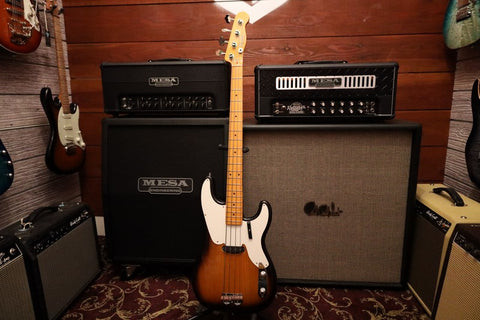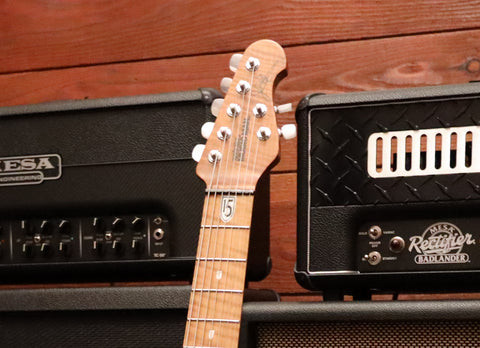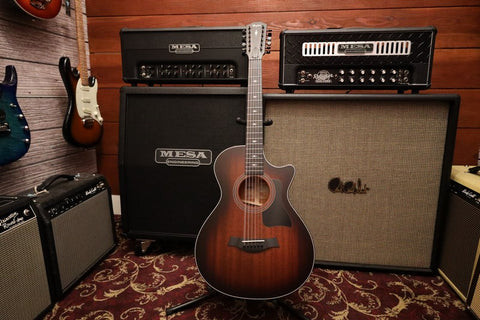The guitar stands as a global icon in the world of musical instruments, celebrated for its versatility and expressive capabilities. Central to the guitar’s unique voice are its strings. These vibrating strands are the very essence of its sound, producing a rich palette of tones and melodies that resonate with musicians across countless genres.
When considering a guitar, one of the first questions that often arises is, “how many strings does a guitar have?” While the most familiar image is that of a six-string guitar, the reality is far more diverse. The number of strings can vary significantly, each configuration offering a distinct sonic character and playing experience.
To truly appreciate the role of strings in shaping a guitar’s identity, it’s essential to delve into the different types of guitars and understand why they have varying numbers of strings.
Understanding the Guitar: A Stringed Instrument
At its core, a guitar is classified as a stringed musical instrument. Typically, a standard guitar features six strings. These strings are crafted from materials like nylon or steel and are meticulously tuned to specific pitches. This tuning arrangement allows musicians to create a vast range of musical sounds, from deep bass notes to bright trebles. The magic happens when these strings are plucked or strummed, giving birth to melodies and harmonies that captivate listeners.
While the six-string configuration is the most common, the guitar family extends beyond this standard. You’ll find guitars with seven, eight, nine, twelve, or even more strings. These variations are not arbitrary; they are designed to cater to specific musical styles and player preferences. Genres like jazz, metal, and classical music often utilize these extended-range instruments to achieve unique sonic textures and broader musical possibilities.
Exploring Different Types of Guitars
To grasp the significance of string numbers, it’s crucial to understand the main types of guitars and how they differ:
- Acoustic Guitar
- Electric Guitar
- Classical Guitar
- Bass Guitar
Each type possesses its own distinct sound and playing style, yet they all share the fundamental principle of creating music through vibrating strings. Understanding these differences sheds light on why string numbers are not uniform across all guitars.
The construction and materials used in each guitar type greatly influence not only the number of strings but also the overall sound produced. Let’s explore some key distinctions.
Electric Guitars: Amplified Versatility
Electric guitars are characterized by their metal strings, a crucial element in their sound production. These strings interact with magnetic pickups, which detect vibrations and convert them into electrical signals that are then amplified. This amplification process is what gives electric guitars their powerful and sustaining sound.
The solid body construction common in electric guitars contributes to their exceptional sustain, allowing notes to ring out for extended periods. This characteristic, combined with their tonal capabilities, has made electric guitars a cornerstone of genres like rock, metal, and blues.
Acoustic Guitars: Natural Resonance
In contrast to electric guitars, acoustic guitars rely on their hollow body construction for sound amplification. The vibrations of the strings resonate within the body, creating a rich and natural acoustic sound. This inherent resonance makes acoustic guitars ideal for genres like folk, country, and pop, where a warm and organic tone is desired.
Acoustic guitars commonly come in two string configurations: six strings and 12 strings. The 12-string variant offers a fuller, chorus-like sound, expanding the sonic possibilities of the acoustic guitar.
Classical Guitars: The Warmth of Nylon
Classical guitars are distinguished by their nylon strings. Unlike the bright and ringing tone of steel strings, nylon strings produce a softer, warmer, and mellower sound. This tonal quality is highly sought after in classical and flamenco music, where nuanced and delicate sounds are paramount.
The use of nylon strings also affects playability, offering a different feel under the fingers compared to steel strings.
 Classical Guitar
Classical Guitar
Bass Guitars: Laying Down the Low End
Bass guitars are designed to operate in a lower frequency range compared to other guitars. Typically, they feature four strings, tuned to produce deep, low-end sounds. The bass guitar’s role is foundational in music, providing rhythm and harmonic support across a wide spectrum of genres. They are essential in creating the groove and underpinning the melodies of other instruments.
The number of strings is a vital factor in defining the sound and style of each guitar type, offering musicians a diverse palette to choose from.
The Standard Six-String Guitar: A Universal Choice
When most people envision a guitar, the six-string model immediately comes to mind. This isn’t merely a matter of convention; the six-string guitar has proven to be a remarkably versatile and enduring design. Its enduring popularity stems from its ability to deliver a wide range of musical expressions suitable for countless musical styles.
Let’s explore the features that have solidified the six-string guitar as a cornerstone of music.
The Layout of the Six-String Guitar
The standard six-string guitar, often referred to as the Spanish guitar, is characterized by its specific tuning. From the thickest (lowest pitch) to the thinnest (highest pitch) string, the strings are tuned to E, A, D, G, B, and E. This tuning arrangement has become a foundational element in music theory and practice, providing a framework for creating bass lines, melodies, and chords all on one instrument.
This configuration was not arbitrarily chosen; it was developed over time to offer the greatest versatility and playability.
Why Six Strings Became the Standard
The six-string layout’s dominance in music is rooted in its exceptional versatility:
- Wide Sonic Range: Six strings effectively cover the range of pitches most commonly used in Western music. This allows guitarists to play lead melodies, rhythmic chords, and even bass lines, making it a comprehensive musical tool.
- Balance of Complexity and Playability: Six strings strike a balance between providing enough notes for complex music and maintaining a manageable learning curve for beginners. It’s accessible yet capable of great complexity.
- Genre Versatility: From rock and blues to pop and classical, numerous genres have embraced the six-string guitar, attesting to its universal appeal and adaptability.
Essentially, the six-string guitar’s enduring popularity lies in its harmonious blend of musical utility and cultural resonance. It’s an instrument that feels intrinsically connected to our musical traditions, a tradition that, for many, is synonymous with six strings.
String Number Variations: Expanding the Guitar’s Sonic Palette
While the six-string guitar enjoys widespread popularity, the world of guitars encompasses a rich diversity of string configurations. These variations are purposefully designed to cater to specialized musical styles and the unique preferences of individual players. Exploring different guitar types with varying string numbers reveals how each configuration unlocks distinct sonic possibilities and playing experiences.
Seven-String and Eight-String Guitars: Delving into Deeper Tones
The seven-string guitar takes the six-string design and expands its tonal range by adding an extra lower string, typically tuned to B. This addition is particularly favored in genres like metal and jazz, where musicians seek a broader sonic palette that includes deeper, more resonant bass notes.
Eight-string guitars push this concept further, incorporating yet another low string, often tuned to F# or E. This extended lower range is invaluable for creating complex, layered musical textures and exploring compositions that demand a wider array of pitches.
 8 String Guitar
8 String Guitar
Twelve-String Guitars: A Chorus Effect
For those seeking a richer, more resonant, and inherently chorus-like sound, the twelve-string guitar is an excellent choice. Instead of single strings, it features courses, which are pairs of strings played together. Each of the six standard guitar strings is doubled, with the pairs tuned in unison or an octave apart.
This string pairing creates a naturally lush and full sound, instantly recognizable in folk, rock, and various popular music styles. However, it’s worth noting that the doubled strings require greater structural robustness and can present a slightly greater playing challenge due to increased string tension and a wider neck.
Alternate Tunings: Reshaping the Guitar’s Sonic Landscape
Beyond the physical structure and number of strings, guitars possess remarkable versatility in their tuning. Alternate tunings offer a powerful way to transform a guitar’s sonic character, providing musicians with a vast array of creative possibilities. Tuning, in essence, refers to the specific pitches assigned to each string, establishing the foundational tonal framework for playing and composing music.
Tuning’s Fundamental Role in Stringed Instruments
Stringed instruments like the guitar are meticulously designed to resonate at specific frequencies. The tuning process aligns these natural resonances with desired musical notes, typically adhering to a well-established musical system. Standard tuning on a guitar, with strings tuned to E, A, D, G, B, and E (from lowest to highest), creates a familiar and logical musical scale for guitarists.
How Alternate Tunings Expand Pitch Possibilities
By altering the pitch of one or more strings, guitarists can unlock new sonic territories and playing techniques. Alternate tunings facilitate new chord voicings, extended harmonic ranges, and easier access to specific intervals and scales. Some tunings, known as open tunings, allow for chords to be played simply by strumming all open strings, effectively changing the entire “landscape” of the fretboard.
Common types of alternate tunings include:
- Dropped Tunings: Lowering the pitch of the lowest (usually 6th) string, often to D. This simplifies playing power chords with barre shapes.
- Open Tunings: Tuning the guitar so that strumming open strings creates a chord (e.g., open G, open D). Ideal for slide guitar and fingerstyle playing.
- Modal Tunings: Tunings designed to emphasize specific musical modes, opening up unique melodic and harmonic avenues.
Each alternate tuning not only shifts the available pitches but can also inspire different stylistic approaches to playing and songwriting. From the deep, bluesy tones of a slide guitar in open G to the intricate fingerpicking patterns enabled by DADGAD tuning, alternate tunings remain a vital source of creative exploration for guitarists across all genres.
Historical and Traditional Guitars: Tracing the Evolution of String Numbers
The guitar’s form and string configuration have been profoundly shaped by its rich history, evolving across cultures and eras. Understanding this historical journey is key to appreciating why the six-string guitar became the modern standard. To understand the prevalence of six strings today, we must explore the instrument’s historical and traditional roots.
Historical and Traditional Variations in String Numbers
The guitar’s ancestors, instruments like the lute, vihuela, and medieval gittern, exhibited a wide variety of string numbers, ranging from four to ten or more. The emergence of the six-string guitar, largely attributed to Spain in the 16th century, marked a turning point. Its versatility and richer harmonic potential led to its widespread adoption, eventually establishing it as the dominant guitar form.
Cultural and Temporal Evolution of String Use
Guitars and related stringed instruments have played pivotal roles in music across the globe, and their string arrangements reflect the musical styles and cultural preferences of their times. For instance, the Baroque guitar often had nine or ten strings arranged in pairs (courses), while the Renaissance guitar typically had four courses. Traditional 12-string guitars, with their doubled strings creating a chorus effect, have roots in Mexican and other folk music traditions.
- European Influence: The introduction of the sixth string in the 1700s in Europe significantly expanded tonal possibilities and gained widespread acceptance.
- Middle Eastern Origins: Early plucked instruments in the Middle East, often played with a plectrum, typically had fewer strings, influencing the development of early European stringed instruments.
- African and Asian Contributions: Instruments like the African kora, with up to 21 strings, and the Asian guqin, demonstrate that guitar evolution was part of a global story of stringed instrument development, not an isolated event.
Exploring the historical and traditional context of the guitar not only clarifies the “why” behind string numbers but also deepens our appreciation for the instrument’s diverse sonic capabilities, which continue to evolve.
 Historical Guitars
Historical Guitars
String Material and Construction: Shaping the Guitar’s Tone
Guitar strings are not just passive elements; they are active participants in shaping the instrument’s tone. Understanding how different string materials and construction methods affect sound is essential for guitarists and anyone interested in the nuances of guitar tone. Let’s examine the tonal contrasts between metal and nylon strings and the impact of string construction on a guitar’s voice.
Metal vs. Nylon: A Contrast in Tonality
The choice between metal and nylon strings is often dictated by musical style and the desired acoustic characteristics. Metal strings, typically made of steel or nickel alloys, produce a bright, clear, and articulate tone. This sonic quality makes them well-suited for genres like rock, country, and folk, where clarity and projection are valued. The crispness of metal strings comes from their higher vibration frequencies and pronounced harmonics.
Nylon strings, commonly found on classical and flamenco guitars, offer a warmer, mellower, and more rounded sound. Their softer material contributes to a nuanced tonal palette, emphasizing rich overtones. The lower tension of nylon strings also contributes to their gentle timbre, favored in classical music and traditional ballads.
Material Science: Refining Acoustic Quality
The science of string materials goes beyond a simple metal versus nylon choice. Alloys and composite materials used in string construction further refine the tonal spectrum. For example, phosphor bronze strings deliver a deep, warm tone with a smooth feel, favored by acoustic guitarists seeking a “woody” and resonant sound.
Coated strings, a technological advancement, not only extend string lifespan but also influence tonal brightness and sustain. Similarly, string gauge, or thickness, affects volume, sustain, and playability. Heavier gauges generally produce a fuller, louder sound with more sustain, while lighter gauges offer easier playability and a brighter tone.
In essence, string material and construction are fundamental in shaping a guitar’s character and playability. Whether it’s the sharp twang of heavy steel strings on an electric guitar or the soothing warmth of nylon strings on a classical guitar, the strings’ properties are integral to the art of guitar music.
- Metal Strings: Bright, articulate, high tension, versatile for many genres.
- Nylon Strings: Warm, mellow, low tension, ideal for classical and flamenco.
- Alloys and Composites: Fine-tune sound and feel.
- Coated Strings: Affect tone and longevity.
- String Gauge: Influences volume, sustain, and ease of playing.
Guitar Genres and String Preferences: Matching Strings to Style
The world of guitars is as diverse as the musical genres they inhabit. Across different musical styles, the number of strings plays a vital role in shaping the sound and playing experience preferred by musicians. Genre conventions often dictate the type of guitar and, consequently, the number of strings a player might choose.
Classical and Flamenco: Tradition of Six Nylon Strings
Classical and flamenco guitarists typically adhere to the traditional six-string nylon-string guitar. This configuration is ideally suited for the intricate melodies and complex fingerpicking techniques that define these styles. The warmth and responsiveness of nylon strings are essential to their sound.
Rock and Metal: Embracing Extended Ranges
In rock and metal, guitarists often venture beyond the standard six strings. Seven-string guitars, popularized by artists like Steve Vai, offer an extended lower range, essential for heavy riffs and soaring solos. Eight-string guitars, used by innovators like Tosin Abasi, further push the boundaries of guitar music in these genres.
Jazz: The Versatility of Six Strings
Jazz musicians, known for complex chord voicings and improvisation, primarily utilize six-string guitars. Legendary jazz guitarists like Wes Montgomery demonstrated the incredible versatility of the six-string in creating innovative sounds and techniques.
Country and Bluegrass: The Twang of Steel Six-Strings
Country and bluegrass genres favor the bright, twangy sound of six-string steel-string acoustic guitars. Iconic figures like Johnny Cash have immortalized the sound of the six-string acoustic in these genres.
Extended-Range Guitars: Pushing Sonic Boundaries
Extended-range guitars, encompassing seven, eight, or more strings, are gaining popularity in experimental and progressive music. These instruments offer a broader sonic palette for crafting novel and unique sounds, pushing the boundaries of conventional guitar music.
- Seven-String Guitars: Favored in genres demanding heavy tones and extended lower registers.
- Twelve-String Guitars: Common in folk and rock for their rich, chorus-like sound, as exemplified by artists like Roger McGuinn of The Byrds and Tom Scholz of BOSTON.
- Extended Range Bass Guitars: Used in jazz fusion and progressive rock, often with six or more strings to accommodate complex musical arrangements.
Understanding these genre-based preferences helps players choose the right string configuration for their musical aspirations. The guitar’s adaptability across genres is a testament to its versatility and the limitless creative possibilities it offers musicians.
Conclusion: Harmonizing with Guitar Strings
Our exploration into the diverse world of guitars reveals that the number of strings is far from a fixed attribute. It’s a variable element, shaped by historical context, playing styles, and the relentless pursuit of musical innovation. From the familiar six strings of a classical acoustic to the expansive ranges of seven, eight, and twelve-string guitars, each configuration presents a unique sonic landscape.
The guitar’s remarkable adaptability across genres is undeniable. It thrives in the hands of classical virtuosos, electrifying rock stars, improvisational jazz musicians, and soulful folk artists. Each guitar type, with its specific string arrangement, contributes a distinct flavor to the music it helps create, showcasing the instrument’s incredible versatility.
Now, it’s your turn to explore the strings of possibility! Whether you’re a novice taking your first steps in music or an experienced player seeking new sonic horizons, experimenting with different guitars and string numbers can unlock exciting discoveries and techniques.
- Feeling Inspired? Pick up a guitar and let your musical journey begin.
- Seeking Knowledge? Delve into our comprehensive guide on guitar maintenance to master string changing and care.
Expanding Your Guitar Journey
Explore our Additional Resources Section for in-depth articles on each guitar type and clarify common terms with our detailed glossary. Armed with this knowledge and the right strings beneath your fingers, the next chapter of your guitar story is ready to be strummed.
Stay curious, keep exploring, and let the strings resonate with your musical spirit!
Share It:
[
